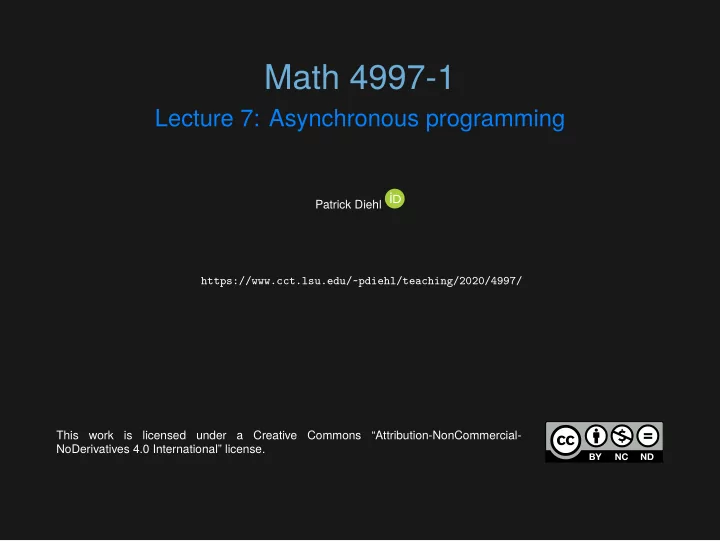

Math 4997-1 Lecture 7: Asynchronous programming Patrick Diehl https://www.cct.lsu.edu/~pdiehl/teaching/2020/4997/ This work is licensed under a Creative Commons “Attribution-NonCommercial- NoDerivatives 4.0 International” license.
Reminder Asynchronous programming Lambda functions Summary References
Reminder
Lecture 6 What you should know from last lecture ◮ Shared memory parallelism ◮ Parallel algorithms and execution policies ◮ Data races and dead locks
Asynchronous programming
Synchronous programming Dependency graph H P X Code auto P = compute(); auto X = compute(); auto H = compute(P,X); functions fjnishes the data is independent ◮ The program is executed line by line ◮ Each time a function is called the code waits until the ◮ We can not compute P and X at the same time, since
Asynchronous programming [3] Code int P,X = 1; std::future<int> f1 = std::async(compute ,P); auto f2 = std::async(compute ,X); std::cout << compute(f1.get() + f2.get()) << std::endl; function has not fjnished yet asynchronous function calls More details: CppCon 2017: H. Kaiser “The Asynchronous C++ Parallel Programming Model” 1 1 https://www.youtube.com/watch?v=js-e8xAMd1s ◮ The program is some times executed line by line ◮ Calling std::async the next line is executed, even if the ◮ We have to use the std::future to synchronize the
Asynchronous execution of functions 2 bool is_prime (int x) { std::cout << "Calculating. Please, wait...\n"; for (int i=2; i<x; ++i) if (x%i==0) return false; return true; } std::future<bool> f = std::async (is_prime ,313222313); function, and so on return type of the function For each call of std::async launches a new thread to execute the function the function pointer fn points to. 2 http://www.cplusplus.com/reference/future/async/ ◮ The fjrst argument fn is a function pointer ◮ The second argument is the fjrst argument of the ◮ The return value is a std::future<T> where T is the
Futurization 3 A std::future provides a mechanism to access the result of asynchronous operations, like std::async and provides methods for synchronization. Synchronization the computation fjnished available for the specifjed timeout duration to become available. It blocks until specifjed timeout time has been reached or the result becomes available, whichever comes fjrst. 3 https://en.cppreference.com/w/cpp/thread/future ◮ .get() returns the result of the functions and wait until ◮ .wait() waits until the computation fjnished ◮ .wait_for(std::chrono::seconds(1)) returns if it is not ◮ .wait_until(std::chrono::seconds(1)) waits for a result
Parallelism using asynchronous programming Example: Taylor series n Approach 2. Start two times std::async where each thread 3. Use the two futures to synchronize the results 4. Combine the two futures to obtain the result ( − 1) n − 1 x 2 n � sin ( x ) = (2 n )! n =0 1. Split n into slices, e.g. 2 times n / 2 for two threads computes n / 2
Implementation I Function double taylor(size_t begin, size_t end, double x,size_t n){ double res = 0; for( size_t i = begin ; i < end ; i++) { res += pow(-1,i-1) * pow(x,2*n) / factorial(2*n); } return res; } threads you want to launch ◮ With begin and end , the range is defjned ◮ The range needs to be adapted to the amount of
Implementation II Launching auto f1 = std::async(taylor ,0,49,2,100); auto f2 = std::async(taylor ,50,99,2,100); Gathering the results double result = f1.get() + f2.get(); Compilation g++ main.cpp -o futures -phtread We need to add -pthread to our compiler to use the POSIX threads to launch the functions asynchronous ( std::async ) More details about POSIX threads [1, 2].
Lambda functions
Lambda expression 4 Structure [ capture clause ] (parameters) -> return -type { definition of method } Notes evaluated by compiler – [&] : capture all external variable by reference – [=] : capture all external variable by value – [a, &b] : capture a by value and b by reference More about the capture clauses in lecture 11/12. 4 https://en.cppreference.com/w/cpp/language/lambda ◮ Generally return-type in lambda expression are ◮ Capture clause:
Practical example std::vector<int> v {4, 1, 3, 5, 2, 3, 1, 7}; Classical function void print(int i){ std::cout << i << std::endl; } std::for_each(v.begin(), v.end(), print); Lambda expression std::for_each(v.begin(),v.end(), [](int i){std::cout<< i << std::endl;})
More examples find_if 5 std::vector<int>:: iterator p = find_if( v.begin(), v.end(), [](int i) { return i > 4; }); std::cout << "First number greater than 4 is : " << *p << endl; Many more algorithms are available in the #include <algorithm> 6 5 https://en.cppreference.com/w/cpp/algorithm/find 6 https://en.cppreference.com/w/cpp/algorithm
Summary
Summary After this lecture, you should know std::future ◮ Asynchronous programming std::async and ◮ Lambda functions
References
References I [1] David R Butenhof. Programming with POSIX threads . Addison-Wesley Professional, 1997. [2] Steve Kleiman, Devang Shah, and Bart Smaalders. Programming with threads . Sun Soft Press Mountain View, 1996. [3] Anthony Williams. C++ concurrency in action : practical multithreading . Manning, Shelter Island, NY, 2012.
Recommend
More recommend